
Heraldry is a discipline relating to the design, display and study of armorial bearings, as well as related disciplines, such as vexillology, together with the study of ceremony, rank and pedigree. Armory, the best-known branch of heraldry, concerns the design and transmission of the heraldic achievement. The achievement, or armorial bearings usually includes a coat of arms on a shield, helmet and crest, together with any accompanying devices, such as supporters, badges, heraldic banners and mottoes.

The European dragon is a legendary creature in folklore and mythology among the overlapping cultures of Europe.
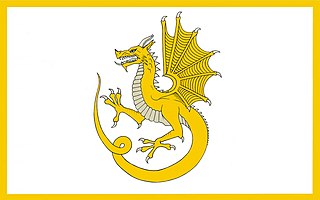
The wyvern is a type of mythical dragon with two legs, two wings, and often a pointed tail which is said to be a venomous stinger.
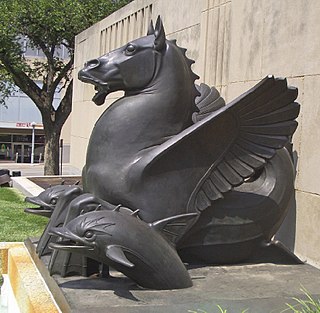
The hippocampus or hippocamp, also hippokampos, often called a sea-horse in English, is a mythological creature shared by Phoenician, Etruscan, Pictish, Roman and Greek mythology, though its name has a Greek origin. The hippocampus has typically been depicted as having the upper body of a horse with the lower body of a fish.

Tincture is the limited palette of colours and patterns used in heraldry. The need to define, depict, and correctly blazon the various tinctures is one of the most important aspects of heraldic art and design.

A cockatrice is a mythical beast, essentially a two-legged dragon, wyvern, or serpent-like creature with a rooster's head. Described by Laurence Breiner as "an ornament in the drama and poetry of the Elizabethans", it was featured prominently in English thought and myth for centuries.
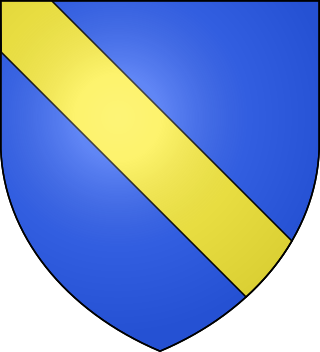
In heraldry, a bend is a band or strap running from the upper dexter corner of the shield to the lower sinister. Authorities differ as to how much of the field it should cover, ranging from one-fifth up to one-third. The supposed rule that a bend should occupy a maximum of one-third of the field appears to exclude the possibility of three bends being shown together, but contrary examples exist.

In heraldry, a charge is any emblem or device occupying the field of an escutcheon (shield). That may be a geometric design or a symbolic representation of a person, animal, plant, object, building, or other device. In French blazon, the ordinaries are called pièces, and other charges are called meubles.

The eagle is used in heraldry as a charge, as a supporter, and as a crest. Heraldic eagles can be found throughout world history like in the Achaemenid Empire or in the present Republic of Indonesia. The European post-classical symbolism of the heraldic eagle is connected with the Roman Empire on one hand, and with Saint John the Evangelist on the other.
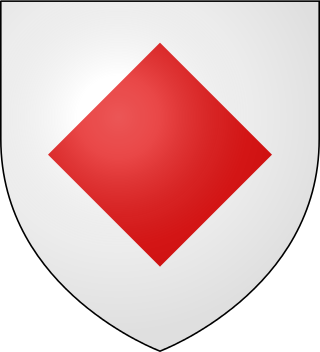
The lozenge in heraldry is a diamond-shaped rhombus charge, usually somewhat narrower than it is tall. It is to be distinguished in modern heraldry from the fusil, which is like the lozenge but narrower, though the distinction has not always been as fine and is not always observed even today. A mascle is a voided lozenge—that is, a lozenge with a lozenge-shaped hole in the middle—and the rarer rustre is a lozenge containing a circular hole in the centre. A field covered in a pattern of lozenges is described as lozengy; similar fields of mascles are masculy, and fusils, fusily. In civic heraldry, a lozenge sable is often used in coal-mining communities to represent a lump of coal.

The lion is a common charge in heraldry. It traditionally symbolises courage, nobility, royalty, strength, stateliness and valour, because historically the lion has been regarded as the "king of beasts". The lion also carries Judeo-Christian symbolism. The Lion of Judah stands in the coat of arms of Jerusalem. Similar-looking lions can be found elsewhere, such as in the coat of arms of the Swedish royal House of Bjelbo, from there in turn derived into the coat of arms of Finland, formerly belonging to Sweden.
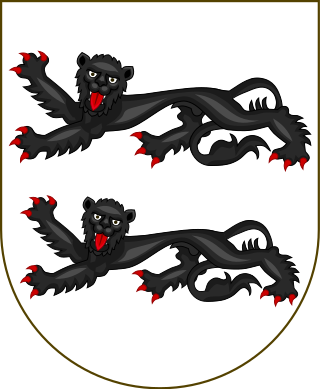
The leopard in heraldry is traditionally depicted the same as a lion, but in a walking position with its head turned to full face, thus it is also known as a lion passant guardant in some texts, though leopards more naturally depicted make some appearances in modern heraldry. The Oxford Guide to Heraldry makes little mention of leopards but glosses leopard as a "term used in medieval heraldry for lion passant guardant. Now used for the natural beast." Another name for this beast is the ounce.

In heraldry and heraldic vexillology, a blazon is a formal description of a coat of arms, flag or similar emblem, from which the reader can reconstruct the appropriate image. The verb to blazon means to create such a description. The visual depiction of a coat of arms or flag has traditionally had considerable latitude in design, but a verbal blazon specifies the essentially distinctive elements. A coat of arms or flag is therefore primarily defined not by a picture but rather by the wording of its blazon. Blazon is also the specialized language in which a blazon is written, and, as a verb, the act of writing such a description. Blazonry is the art, craft or practice of creating a blazon. The language employed in blazonry has its own vocabulary, grammar and syntax, which becomes essential for comprehension when blazoning a complex coat of arms.

A martlet in English heraldry is a mythical bird without feet that never roosts from the moment of its drop-birth until its death fall; martlets are proposed to be continuously on the wing. It is a compelling allegory for continuous effort, expressed in heraldic charge depicting a stylised bird similar to a swift or a house martin, without feet. It should be distinguished from the merlette of French heraldry, which is a duck-like bird with a swan-neck and chopped-off beak and legs. The Common Swift rarely lands outside breeding season, and sleeps while airborne.

The wolf has been widely used in many forms in heraldry during the Middle Ages. Though commonly reviled as a livestock predator and man-eater, the wolf was also considered a noble and courageous animal, and frequently appeared on the arms and crests of numerous noble families. It typically symbolised the rewards of perseverance in long sieges or hard industry.

In heraldry, the term attitude describes the position in which a figure is emblazoned as a charge, a supporter, or as a crest. The attitude of a heraldic figure always precedes any reference to the tincture of the figure and its parts. Some attitudes apply only to predatory beasts, exemplified by the beast most usual to heraldry – the heraldic lion; other terms apply to docile animals, such as the doe, usually emblazoned as a "hind".

In heraldic achievements, the helmet or helm is situated above the shield and bears the torse and crest. The style of helmet displayed varies according to rank and social status, and these styles developed over time, in step with the development of actual military helmets. In some traditions, especially German and Nordic heraldry, two or three helmets may be used in a single achievement of arms, each representing a fief to which the bearer has a right. For this reason, the helmets and crests in German and Nordic arms are considered essential to the coat of arms and are never separated from it.

In heraldry, the term sea-lion refers to a legendary creature that has the head and upper body of a lion, but with webbed forelimbs and a fish tail. These occur most frequently as supporters, but also occur as crests and occasionally as charges. Sea-lions are frequently found in "sejant" or "sejant-erect" attitudes, but may also be found "naiant" or "assurgeant".

The heads of humans and other animals are frequently occurring charges in heraldry. The blazon, or heraldic description, usually states whether an animal's head is couped, erased, or cabossed. Human heads are often described in much greater detail, though some of these are identified by name with little or no further description.
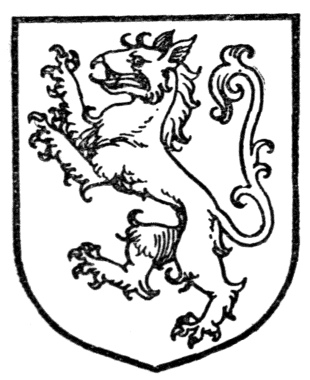
Tyger, also known as heraldic tiger or tygre, is an imaginary beast used as a charge in heraldry.


















